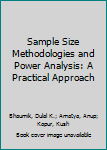Sample Size Methodologies and Power Analysis: A Practical Approach
With a focus on statistical and epidemiological applications, the authors present sample size calculation methods for various study designs ranging from simple twogroup comparison assuming normal distribution to complicated multilevel designs involving linear and nonlinear models. The book also combines existing results with R software applications to implement the discussed methods. Sample size estimation is an important, but often, challenging aspect of designing a research study as it involves interrelation between number of subjects ( n ), significance level (), effect-size ( ES ) and power (1). When sample size is underestimated, studies lack sufficient power to detect statistically significant differences, and as a result, important scientific discoveries can be missed. Alternatively, overestimation of sample size leads to wastage of time, money and manpower. Conclusions drawn from overpowered studies can be statistically significant, but clinically meaningless, so it is necessary to estimate appropriate sample sizes to correctly identify significance when it exists without wasting valuable resources. The book presents an overview of related mathematical concepts for statisticians as well as the theoretical background for power and sample size calculation. In addition, comprehensive coverage of existing methodologies for sample size and power analysis is provided. The authors review existing software for sample size calculation and utilize R for sample size calculations. Extensive reallife examples demonstrate the examples illustrate the power characteristics of sample size methods.
Format:Hardcover
Language:English
ISBN:1119005698
ISBN13:9781119005698
Release Date:August 2022
Publisher:Wiley
Length:448 Pages
Customer Reviews
0 rating





